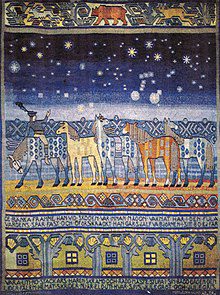
Märta Måås-Fjetterström
Interested in selling Märta Måås-Fjetterström rugs or textiles?
We have received top dollar for Märta Måås-Fjetterström rugs. Auction is the best way to quickly and transparently get maximum dollar for your artwork.
Märta Måås-Fjetterström: Modernist Swedish Rugs
Märta Måås-Fjetterström is a Swedish textile company known for their vibrant, modernist designs. Founded in 1919, the company still produces acclaimed rugs even today.
Märta Måås-Fjetterström’s History
The founder of the Swedish company, Märta Fjetterström, was born in 1873 in Kimstad, Östergötland, near the southern Baltic region of Sweden. At age 17, she left home to study illustration at the School of Industrial Arts (the modern-day Konstfack School of Arts, Craft, and Design) in Stockholm. Upon her graduation, she began working as a drawing teacher; at this time, she adopted the name Måås-Fjetterström.
She taught for a few years before joining George Karlin’s studio as a textile designer. From there, Måås-Fjetterström left the studio to manage a newly opened textile college, the Malmöhus County Handicraft Association. In 1909, she showed a large tapestry titled Staffan Stalledräng, at the Stockholm Art Exhibition; this tapestry diverged from traditional Scandinavian patterns, and this led to her termination from the college. Consequently, Måås-Fjetterström moved to Vittsjö to head another weaving school, Zickermännerna, where she was allowed more creative liberty.
By 1919, she left the school to create her own studio, Märta Måås-Fjetterström. She was 46 at the time and had been teaching for nearly 20 years. By 1930, the Märta Måås-Fjetterström studio was flourishing with multiple acclaimed exhibitions at Stockholm.
The company grew famous for its eclectic details and patterns. Many of their tapestries, rugs, and carpets featured watercolor sketches and pictorial motifs, designed by Måås-Fjetterström herself. Their works were inspired by the modernist movement, which had overtaken Sweden at the time.
By the time she died in 1941, Måås-Fjetterström had established herself as an innovative and revered textile artist. Upon her death, her siblings wished to close the studio, as neither they nor Måås-Fjetterström had any children to pass it on to. However, Måås-Fjetterström’s friend and colleague, Carl Malmsen, stepped in to preserve her work.
Malmsen took over the studio with the help of the Swedish Royal family, particularly King Gustav V and Crown Prince Gustaf Adolf. They managed to safeguard her textiles and sketches, eventually reopening the studio in 1942.
Malmsen hired upcoming textile designer, Barbro Nilsson, as the studio’s next art director. During her era, the studio delved further into unique patterns and techniques, aiming to uphold Måås-Fjetterström’s legacy.
The new set of designers and weavers learned Måås-Fjetterström’s original patterns, continuing the production of her designs. Eventually, Nilsson retired in 1970, passing the directorship to another designer. The company still produces exceptional textiles even today.
Notable Works by Måås-Fjetterström
Throughout its 100-year history, the Måås-Fjetterström company has produced timeless, modernist-style textiles. The studio is known particularly for its weavings, including rugs, tapestries, drapes, and pillow covers.
The company distinguishes itself through its modernist, geometric designs, which put innovative spins on traditional weaving methods, such the knotted pile technique and rölakan flat weave style. Moreover, Måås-Fjetterström and her successive directors created weaving styles exclusive to their brand, with the gobeläng flat weave as a notable example.
Märta Måås-Fjetterström’s early works are characterized by their focus on folkloric traditions, modernized through her bold use of color and imagery. Another key artisan from the Måås-Fjetterström company is Ann-Mari Forsberg, who began working for the studio in the early 40s. Her textiles are noted for their incorporation of floral designs with modernist undertones.
Måås-Fjetterström Market Value
Märta Måås-Fjetterström’s original works are highly valued. Many of her textiles are displayed at prominent art museums, including the Museum of Modern Art in New York City. Moreover, many of her rugs and tapestries are framed in Swedish embassies around the world. Some of her works are even part of the Swedish Royal Family art collection.
As such, the market for her originals is very high. While her works often sell for over a thousand dollars, the studio’s weavings can reach prices in the six figures in international sales.
Original works by Barbro Nilsson and Marianne Richter, who worked for the studio until the early 21st century, originals can sell for even more. Nilsson’s designs have sold for prices anywhere between $50,000 and $60,000; while Richter’s designs are not often priced as high, they can still sell for tens of thousands of US dollars.
Appraise and Sell Works by Märta Måås-Fjetterström
If you have any works by the Märta Måås-Fjetterström studio, including those by Måås-Fjetterström herself, Barbro Nilsson, or Marianne Richter, get in touch with our experts at Revere Auctions. If you would like to sell your Måås-Fjetterström textiles, you can auction them at our location in St. Paul, Minnesota. We also offer our services online.
You can contact us anytime for a free auction estimate if you want to sell textiles by Märta Måås-Fjetterström. We have a very simple process. After you send us the photos of the work, our experts will take a look, analyze, and provide you an estimate of the amount the artwork is likely to reach at auction.
If you need an appraisal for Märta Måås-Fjetterström rugs or textiles, we provide a certified appraisal report that can be used for estate taxes, donations, and insurance coverage. Our appraisals are compliant with Uniform Standards of Professional Appraisal Practice and are accepted by insurance companies, charity agencies, and the IRS.